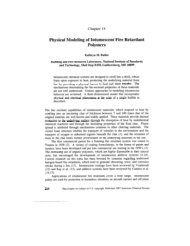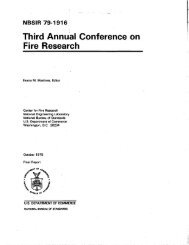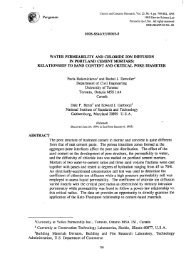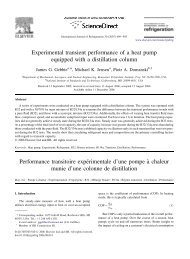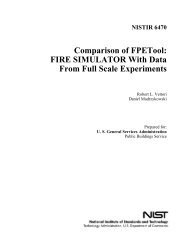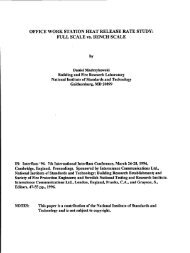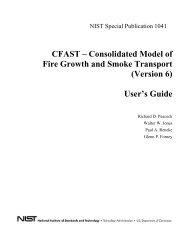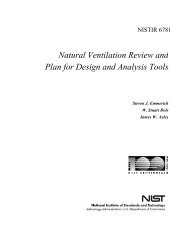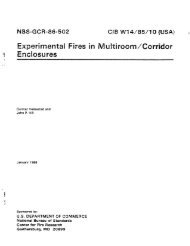Study of Technology for Detecting Pre-Ignition Conditions of ... - NIST
Study of Technology for Detecting Pre-Ignition Conditions of ... - NIST
Study of Technology for Detecting Pre-Ignition Conditions of ... - NIST
Create successful ePaper yourself
Turn your PDF publications into a flip-book with our unique Google optimized e-Paper software.
CPSC-LW--95-1I45<br />
The pan area was monitored with several thermocouples. Two thermocouples contacted<br />
the food inside the pan near the center at the bottom and approximately-7 mm (0.3 in) above the<br />
bottom. These themomuples were Omega model number KMQSS-020(G)-12 [stainless-steel<br />
sheathed, O.51 mm (0.020 in) sheath dimeter, K-type (C%romel-Alumel), grounded, 30 cm<br />
(12 in) long]. The temperature inted?ace between the cooking element and pan was measured<br />
with another O.51 mm (0.020 in) sheathed thermocouple. In the case <strong>of</strong> the electric range, the<br />
themomuple was sandwiched between the centermost ring <strong>of</strong> the resistive element and the pan.<br />
For the gas range, the thermocouple was located in the outer 2 cm (0.8 in) <strong>of</strong> the pan diameter<br />
so as not to be in the flame itself. The tiemomuple was bent to cause contact with the pan<br />
bottom. A special washer tiemocouple assembly (a thermocouple designed as a boltable washer)<br />
was attached to the inside <strong>of</strong> each pan using an 6-32 type screw and nut through a 3.6 mm<br />
(9/64 in) diameter through-hole 1.8 cm (0.7 in) above the bottom (inside) <strong>of</strong> the pan. This<br />
thermoccmple was Omega model number WTK-6-60 [20 gauge, 0.368 cm (0.145 in) washer<br />
diameter, M3.5 (#6) screw size, K-type (Ckomel-Mumel), 152 cm (60 in) long, glass braid<br />
insulation] and was used to estimate the metal tempera~re at ignition since the ignition location<br />
was most likely the hot metal surface where it interfaced with the food.<br />
Thermocouples were placed at several other locations around the range and range hood<br />
where it would be relatively easy to locate a built-in sensor. The thermocouples were Omega<br />
model no. SA1-K [30 gauge, 0.25 mm (0.01 O in) diameter, K-type (Ckomel-Mumel), 91 cm<br />
(36 in) long, Teflon insulated, self-adhesive backing]. The locations were as follows: 17 cm<br />
from the center <strong>of</strong> the burner at the 2 and 8 o’clock positions (60 0 and 2400 clockwise from<br />
rear <strong>of</strong> burner, respectively); mounted on the range hood’s vertical front wall both inside and<br />
outside, centered above the active burneq below the range top under the burner area (electric<br />
only); and on top <strong>of</strong> the range back, directly behind the burner (gas only). The thermocouple<br />
below the electric range top was only implemented <strong>for</strong> a few tests.<br />
2.2.2 Laser Attenuation Apparatus<br />
In order to detemine relative aerosol mass mncentiation above the cooking are% two He-<br />
Ne laser attenuation systems were arranged such that the beams passed through the axis <strong>of</strong><br />
symmetry <strong>of</strong> the pan 17.8 cm (7 in) and 27.9 cm (11 in) above the burner surface. The He-Ne<br />
lasers were Melles Griot model number 05-LLR-811, and each generated a beam with 1 mW<br />
power. They were mountd on a vetiical-timslation stand which provided the ability to finely<br />
adjust their position. The tiasmitied light was received by two photodiodes which were mounted<br />
on opticai rods and connected to a power source. The photodiodes (Hamamatsu S 1337- 101 OI3Q,<br />
100 mmz active surface area), operational amplifier circuits, power source box, and mounting!<br />
with connections <strong>for</strong> power input and signal output were the same as those used by I?itts et al.s<br />
The pre-test output <strong>of</strong> the devices with unobstmcted laser light was 8-10 V.<br />
2.2.3 Bi-directional Probe<br />
The vertical gas velocity above the cooking<br />
directional probe and a sensitive pressure transducer.<br />
12<br />
area was measured through the use <strong>of</strong> a bi-<br />
The probe was stainless steel with 14.3 mm



